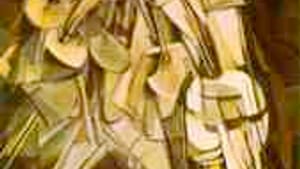Stay in the Loop
BSR publishes on a weekly schedule, with an email newsletter every Wednesday and Thursday morning. There’s no paywall, and subscribing is always free.
In the Art Museum's attic with Pablo
"Picasso and the Paris Avant-Garde' at the Art Museum (3rd review)

Michael Taylor, the Art Museum's curator of modern art, has fashioned an installation that unveils, for the first time in recent memory, the astonishing range, depth, and quality of the Art Museum's Picasso holdings.
"Picasso and the Avant-Garde in Paris" is the first major exhibit crafted since Timothy Rub was appointed last year. It also gives Rub a foretaste of the curatorial excellence that he can expect when the Art Museum's staff mounts a rilly big shew. Such star-quality production numbers were a hallmark of Rub's late predecessor, Anne d'Harnoncourt, who was among those who almost invented the genre.
Taylor's exhibition is a few bricks short of a d'Harnoncourt blockbuster. There's no made-to-order catalogue. No plastic wrap on the Museum's east front "Rocky" steps. No road-show destinations. And most significantly, no borrowed material. Hardly the kind of spectacle that d'Harnoncourt might have ringmistressed.
But, then, why? Financial considerations? Sure— especially when the Museum is experiencing well-known shortfalls and an endowment plunge. Still, Taylor— a surprisingly masterful virtuoso at only 42— has demonstrated that the Art Museum can do justice to every nuance in the Picasso saga.
Unseen for decades
Taylor has emptied the Museum's attic and dusted off 214 paintings, sculptures, photographs and other artworks that even Art Museum faithful haven't seen in decades— and, undoubtedly, never in such a grouping. (Much of the artwork is drawn from the A.E. Gallatin and the Louise and Walter Arensberg collections.)
The visitor traces Picasso's artistic tour de force in a gallery walkabout that's introspective, scholarly and, yes, even academic. (Taylor also teaches at the University of Pennsylvania). It's mellifluously coherent too, thanks to Taylor's audio narrative. (Rub gives the overall introduction).
The story line is linear, tracing Picasso's prodigious inventiveness from 1905 to 1945 while he lived in Paris in self-imposed exile from his native Spain, then dominated by fascism. The period is also significant for kick-starting a creativity that endured through the rest of the artist's life, until his death in 1973 at 92. It was also a 40-year period in which Picasso dominated the forefront of change: the birth of Cubism; Synthetic Cubism (involving his works in collage and papier collé); and Surrealism.
1,000 visitors an hour
I'm always surprised at the way the Museum's one-size-fits-all special exhibition space, the Dorrance Galleries, manages to accommodate all comers. Those galleries, now with freshly white-painted walls (one exception), serve this show well. This especially since crowds are gathering. (The day I visited, during a member viewing, a guard told me he was clicking in almost 1,000 attendees per hour).
Picasso's 1906 self-portrait, the show's signature piece, occupies a pride of place in Gallery 1. The figure is dressed like a boxer, according to Taylor: "Very muscular, with a mask-like quality."
Other key pieces follow in quick succession. Man with a Guitar (1912), Three Musicians (1921), counter-pointed— here is Taylor at his best— by works by Picasso's Paris fellow-travelers like Georges Braque, Fernand Léger, Marc Chagall, Jacques Lipchitz and Man Ray.
This contextual envelope includes photographs of other Parisian notables and, separately in Gallery 5's high-ceiling space, Marcel Duchamp's iconic Nude Descending a Staircase.
Cry for peace
The show concludes with a lightening bolt, one of Picasso's best known and heart-breaking sculptures, Man With a Lamb (1943-1944). The bronze, crafted from 1943 to 1944, is a bold, visually stunning testament of Picasso's reference for peace. It's all the more dramatic in that it was executed when Paris was still under Nazi occupation.
Taylor, in his audio guide, called the work a "prayer" for the liberation of Paris and its survivors. It's now, as well, "a memorial to the French resistance," he said.
A few quibbles
Some distractions?
Nude Descending is difficult to view. Unlike virtually all the works in other rooms, which are hung at eye level, Nude Descending and several other works are raised above, beyond a clear sight line. This problem is further compounded by lighting that ricochets off the picture's glass case, and by crowds that force a viewer to retreat to better vantage points.
The photographs also introduce some extraneous context links. I've always liked the ubiquitous photograph of F. Scott Fitzgerald in his Brooks Brother shirt. But I found it a contextual stretch, given that the portrait was probably snapped in Baltimore.
I was also disconcerted by the labeling, which provided no canvas dimensions. I guessed at the size of one of my favorite urban landscapes, Léger's The City (1919). It's about eight feet by ten. My guess was way off.
Where's Guernica?
Further, a companion complained that no graphic rendering of Picasso's most favorite painting, Guernica, was offered as reference— even though that iconic anti-war image was mentioned several times in relation to Salvador Dali's 1936 Self Construction with Boiled Beans (Premonition of Civil War). Also missing: Any mention of Amedeo Modigliani.
These are just small bumps in an otherwise a seamless journey of pleasure, wonderment and learning.
By the way, if you haven't had your fill of Picasso, the Metropolitan Museum of Art plans more. The Met kicks off its show, also using only works from its collection, on April 27, running to August 1.♦
To read another review by Andrew Mangravite, click here.
To read another review by Marilyn MacGregor, click here.
To read a response, click here.
"Picasso and the Avant-Garde in Paris" is the first major exhibit crafted since Timothy Rub was appointed last year. It also gives Rub a foretaste of the curatorial excellence that he can expect when the Art Museum's staff mounts a rilly big shew. Such star-quality production numbers were a hallmark of Rub's late predecessor, Anne d'Harnoncourt, who was among those who almost invented the genre.
Taylor's exhibition is a few bricks short of a d'Harnoncourt blockbuster. There's no made-to-order catalogue. No plastic wrap on the Museum's east front "Rocky" steps. No road-show destinations. And most significantly, no borrowed material. Hardly the kind of spectacle that d'Harnoncourt might have ringmistressed.
But, then, why? Financial considerations? Sure— especially when the Museum is experiencing well-known shortfalls and an endowment plunge. Still, Taylor— a surprisingly masterful virtuoso at only 42— has demonstrated that the Art Museum can do justice to every nuance in the Picasso saga.
Unseen for decades
Taylor has emptied the Museum's attic and dusted off 214 paintings, sculptures, photographs and other artworks that even Art Museum faithful haven't seen in decades— and, undoubtedly, never in such a grouping. (Much of the artwork is drawn from the A.E. Gallatin and the Louise and Walter Arensberg collections.)
The visitor traces Picasso's artistic tour de force in a gallery walkabout that's introspective, scholarly and, yes, even academic. (Taylor also teaches at the University of Pennsylvania). It's mellifluously coherent too, thanks to Taylor's audio narrative. (Rub gives the overall introduction).
The story line is linear, tracing Picasso's prodigious inventiveness from 1905 to 1945 while he lived in Paris in self-imposed exile from his native Spain, then dominated by fascism. The period is also significant for kick-starting a creativity that endured through the rest of the artist's life, until his death in 1973 at 92. It was also a 40-year period in which Picasso dominated the forefront of change: the birth of Cubism; Synthetic Cubism (involving his works in collage and papier collé); and Surrealism.
1,000 visitors an hour
I'm always surprised at the way the Museum's one-size-fits-all special exhibition space, the Dorrance Galleries, manages to accommodate all comers. Those galleries, now with freshly white-painted walls (one exception), serve this show well. This especially since crowds are gathering. (The day I visited, during a member viewing, a guard told me he was clicking in almost 1,000 attendees per hour).
Picasso's 1906 self-portrait, the show's signature piece, occupies a pride of place in Gallery 1. The figure is dressed like a boxer, according to Taylor: "Very muscular, with a mask-like quality."
Other key pieces follow in quick succession. Man with a Guitar (1912), Three Musicians (1921), counter-pointed— here is Taylor at his best— by works by Picasso's Paris fellow-travelers like Georges Braque, Fernand Léger, Marc Chagall, Jacques Lipchitz and Man Ray.
This contextual envelope includes photographs of other Parisian notables and, separately in Gallery 5's high-ceiling space, Marcel Duchamp's iconic Nude Descending a Staircase.
Cry for peace
The show concludes with a lightening bolt, one of Picasso's best known and heart-breaking sculptures, Man With a Lamb (1943-1944). The bronze, crafted from 1943 to 1944, is a bold, visually stunning testament of Picasso's reference for peace. It's all the more dramatic in that it was executed when Paris was still under Nazi occupation.
Taylor, in his audio guide, called the work a "prayer" for the liberation of Paris and its survivors. It's now, as well, "a memorial to the French resistance," he said.
A few quibbles
Some distractions?
Nude Descending is difficult to view. Unlike virtually all the works in other rooms, which are hung at eye level, Nude Descending and several other works are raised above, beyond a clear sight line. This problem is further compounded by lighting that ricochets off the picture's glass case, and by crowds that force a viewer to retreat to better vantage points.
The photographs also introduce some extraneous context links. I've always liked the ubiquitous photograph of F. Scott Fitzgerald in his Brooks Brother shirt. But I found it a contextual stretch, given that the portrait was probably snapped in Baltimore.
I was also disconcerted by the labeling, which provided no canvas dimensions. I guessed at the size of one of my favorite urban landscapes, Léger's The City (1919). It's about eight feet by ten. My guess was way off.
Where's Guernica?
Further, a companion complained that no graphic rendering of Picasso's most favorite painting, Guernica, was offered as reference— even though that iconic anti-war image was mentioned several times in relation to Salvador Dali's 1936 Self Construction with Boiled Beans (Premonition of Civil War). Also missing: Any mention of Amedeo Modigliani.
These are just small bumps in an otherwise a seamless journey of pleasure, wonderment and learning.
By the way, if you haven't had your fill of Picasso, the Metropolitan Museum of Art plans more. The Met kicks off its show, also using only works from its collection, on April 27, running to August 1.♦
To read another review by Andrew Mangravite, click here.
To read another review by Marilyn MacGregor, click here.
To read a response, click here.
What, When, Where
“Picasso and the Avant-Garde in Paris.†Through May 2, 2010 at Philadelphia Museum of Art, Benjamin Franklin Parkway at 26th St. (215) 763-8100 or www.philamuseum.org.
Sign up for our newsletter
All of the week's new articles, all in one place. Sign up for the free weekly BSR newsletters, and don't miss a conversation.

 Richard Carreño
Richard Carreño